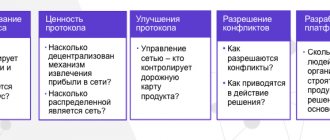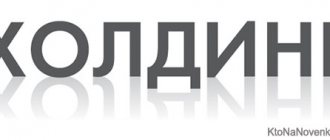The concept and essence of centralization and decentralization
The most important principles of management activities are the principles of centralization and decentralization, which are the basis of organizational forms of management. The centralized form provides for the management of the economic activities of the enterprises that are part of the company from one center, strict regulation and coordination of their activities, the complete absence of their economic independence to such an extent that their responsibility for the sale of products ceases after they have shipped their products to the marketing organ of the company. This form of organization is usually used by small companies producing one type of product or one industry, the technological process of which is closely related, operating mainly in the extractive industries and focused on the local or national market[5].
Two main opposing sectors, between which the right balance must be maintained, are centralization and decentralization (Fig. 1.1). The first leads to a clear hierarchy, unity of management and purpose, and the second leads to a division of labor at all levels, including management.
The advantages of hierarchy can be considered as a vertical division of labor, when the boss is given authority and responsibility for each job. The result is that subordinates are manageable and take their work seriously. Management is organized through discipline, which includes rewards and punishments. Some of these principles are primarily related to human factors. Personnel management involves creating a corporate spirit and stimulating initiative, which immediately affects harmony in the team and the successful development and implementation of plans entrusted to people. The division of labor, both vertically and horizontally in the hierarchy, increases the speed of work and its quality by concentrating attention and effort on a narrow task. But the final decision should not be made collectively
The organizational structure is considered centralized when: functional departments play a more important role than production ones; there are a large number of functional services (departments); research departments are located in the central office of the parent company; with a powerful production and sales apparatus, the sales network of production departments is subordinate to the central sales department; functional departments of the central office of the parent company exercise functional control over the department.
A decentralized form of management involves the creation of production departments within the company that have complete economic independence, i.e. endowed with broad powers in both production and marketing spheres and responsible for making a profit [33]. The top management of the company retains the functions of monitoring the operational activities of departments, coordinating their work and determining the main directions for ensuring the efficiency and profitability of the company, as well as carrying out long-term planning. As a rule, production branches are entrusted with full responsibility for organizing production and sales activities. Each production unit finances its own business and enters into commercial partnerships with any third parties. However, the very fact of creating production units does not mean that the enterprise is managed on the basis of decentralization. The degree of decentralization is determined by the extent to which branch managers are given authority or rights to make independent decisions.
What is DAO?
DAO is a decentralized autonomous organization. The code is written by a decentralized organization that provides a sort of governance mechanism.
The DAO can be used to automatically award funds based on established criteria.
"The DAO" was one of the largest and earliest examples of DAO. It was created by Slock.it and built on the Ethereum network. This is an open source project that anyone can contribute to.
The DAO was designed to operate as a venture fund platform for crypto projects. An offer was made and anyone with The DAO tokens could vote for projects to receive funding. However, The DAO never made it to launch.
The DAO raised 12.7 million Ether, which was worth about $150 million at the time.
Types of centralized and decentralized firms
The term "centralization" refers to the degree of concentration of decision making in one hand, which is associated only with formal authority, i.e. with the rights that a specific person in an organization has
The term "decentralization", on the other hand, has two main meanings:
- First, it refers to the dispersion of official power along the chain of command. In principle, the “first in line” for power is always the head of the organization. Either the manager decides that it will be concentrated in his hands, or it will be distributed among employees - delegated vertically down the hierarchy. The distribution of power along the chain of command is called vertical decentralization.
- The right to make decisions - in this case predominantly informal - may belong to line managers in the system of formal authority, or it “flows” beyond the linear structure - to analysts, support specialists and operators. Horizontal decentralization means the influence of non-managers in the decision-making process
Vertical decentralization means delegating decision-making authority down the chain from the head of the organization to the middle line. In this case, the main role is given to formal power (choice and its authorization), in contrast to informal power belonging to consultants and managers. In the case of vertical decentralization, the following questions must be answered:
- What decision-making rights should be delegated along the chain of authority?
- How far up the chain of authority should delegation go?
- How should the use of these rights be coordinated (or controlled)?
These three issues are closely interrelated. Let us first look at some facts about selective decentralization along the chain of authority. It is believed that corporations should delegate much more rights down the chain of authority for production and marketing than for financial and legal decisions. Decision-making authority usually remains at the level at which the necessary information can best be gathered [8]. For example, in the plastics industry, research and development decisions involve highly complex knowledge that is accessible to the scientist or laboratory manager and is unlikely to be transferred to a higher level of the hierarchy. Consequently, such decisions are usually made at relatively low levels of the hierarchy. On the other hand, production decisions here are made at the upper levels (by the plant director), where all the necessary information can be concentrated. Marketing decisions can be made at both upper and lower levels.
Each group exists at the level of the hierarchy where it is best able to gather information about decisions in the functional area. Using Figure 1.2, we combine these data and combine four operational constellations: the financial constellation is at the top, the production constellation at the bottom, then the marketing constellation, and finally the research constellation. Thus, selective vertical centralization is logically linked to constellations created on a functional basis. (Note that in this case, decentralization can be not only vertical, but also horizontal; as shown in Fig. 1.2, hardware groups are combined into three constellations at the highest hierarchical levels, and the fourth is purely service).
Advantages and disadvantages of centralized and decentralized firms
In the conditions of the existence of giant enterprises with mass production of homogeneous products, the tendency towards centralization of management prevailed, since production conditions created the most favorable soil for it and made it possible to realize its advantages, which were as follows:
- firstly, in strengthening the strategic focus of the management process and ensuring, if necessary, the concentration of resources in key areas of the organization’s activities;
- secondly, in eliminating unjustified duplication of management functions, which leads to cost savings (for example, instead of accounting in each division of the company there is a single accounting department with a smaller staff)
- thirdly, the concentration of the decision-making process in the hands of those who know the general situation better, have a broader outlook, knowledge and experience
However, the centralization of power has its downside - a lot of time is spent on transmitting information, during which a significant part of it is lost or distorted; the most important decisions are made by those who are cut off from life and do not know the specific situation well, and the performers who know the situation well are removed from the development and adoption of decisions, and they are imposed on them by force. As a result, the decisions made are of insufficient quality and are not implemented effectively in practice.
A way to curb the excessive independence of units is selective centralization, which implies that, along with providing them with greater freedom of action, their leaders fall into strict personal subordination to the first person of the organization, becoming his deputies, and, therefore, are forced in this capacity to unconditionally obey the instructions of the central government
Advantages of centralization:
- Centralization improves control and coordination of specialized independent functions and reduces the number and extent of erroneous decisions made by less experienced managers.
- Strong centralized management avoids a situation where some departments of the organization grow and develop at the expense of others or the organization as a whole.
- Centralized management makes it possible to more economically and easily use the experience and knowledge of the staff of the central administrative body.
In conditions of significant complication of production and information processes, an increase in the number and degree of economic independence of entities included in the organization, their territorial dispersion, rapid changes in the environment, and a geometric increase in the number of decisions made, a real need arose to decentralize the management process. This allows, firstly, to quickly develop and make decisions, including with the participation of direct executors; secondly, to more clearly reflect the objective situation in these decisions; thirdly, refuse detailed instructions from the center, thereby reducing its overload with secondary problems and reducing information flows
However, decentralization of management is accompanied by a number of negative consequences that must be taken into account in practice. First of all, due to the isolation of the decision-making process and its concentration at the lower levels of the management structure, the interests of other departments and the organization as a whole are often poorly taken into account or ignored, which often leads to tactical, petty and ineffective decisions. Due to the lack of common rules and procedures for developing and making decisions, “shaking” takes a lot of time and is not always successful. Finally, decentralization can lead to separatism, which is extremely detrimental to the organization
Introduction
The topic of this development is formulated based on real practical needs and carried out in the conditions of a real working organization.
Issues of distribution of powers and responsibilities are caused by internal contradictions, when, on the one hand, management is carried out using traditional methods, on the other, something new is introduced into management practice, caused by the active formation of economic relations at a new level. However, more attention is paid to the problem of responsibility, and from the point of view of its distribution, rather than control, which is the previous stage. When completing this coursework, sources were used in approximately equal proportions, including classical literature on management, work experience, modern trends in management practice and personal reflections.
So, the purpose of the work is to analyze the features of centralization and decentralization in the management of an organization. The subject of the study is the advantages and disadvantages of centralization and decentralization, factors contributing to decentralization.
Indicators used to assess the degree of centralization and decentralization
Decentralization cannot be considered in isolation from centralization. There cannot be a completely decentralized structure - it will lose its integrity. But there cannot be an organization completely devoid of decentralization - with the loss of autonomy it will lose its structure. Thus, it is the degree of decentralization, expressed by the relationship between centralization and decentralization of management at a given enterprise, that is essential
Strict centralization deactivates department managers and teams and leads to a decrease in the efficiency of the organization. Excessive decentralization creates a gap between the goals of the unit and the organization. Positive activities at the unit level can become negative at the level of the organization as a whole. And this, accordingly, will lead to a decrease in the efficiency of the organization as a whole [30].
The optimal level of decentralization of management, which makes it possible to ensure both the activation of the activities of lower divisions and the orientation of their activities towards increasing the overall efficiency of the organization, is determined by the characteristics of a particular enterprise, the characteristics of this field of activity and the specifics of the current situation.
A certain form of compromise between centralization and decentralization is polycentrism. The polycentric structure retains the priority of a single coordinating center, but at the same time ensures the high importance of second-level centers that are close to the periphery of the organization and have more opportunities for timely adaptive response
At the same time, there are many indicators of decentralization of management. For example, the following indicators of decentralization: the number of decisions made at lower levels of management; the importance of decisions made at lower levels of management; the number of functions that are affected by decisions made at lower levels of management; degree of control exercised over these decisions
The most important for assessing the level of centralization/decentralization are not quantitative indicators - the volume of transferred powers, but qualitative characteristics - the significance of the transferred powers in the overall system of management functions implemented at the enterprise and the degree of independence of the lower division in the implementation of these powers. If personnel at lower levels of the organization make many decisions, but these decisions are “programmed” by the organization’s policies, then the degree of centralization remains high. Also, if the assessment of management activities is given at the top level of the organization, then this is centralization, regardless of at what level decisions are made. Thus, when assessing the level of centralization/decentralization, it is important to consider the extent to which decentralization of management is accompanied by decentralization of power
An objective assessment of the level of centralization/decentralization can be given according to a single criterion, reflecting the distribution of powers between the management center and divisions in the most important areas of management decision-making related to the functioning of divisions. Among these areas we can highlight:
- personnel transfer,
- personel assessment,
- salary,
- structure of subsections,
- Labour Organization,
- equipment and production technology,
- operational planning
Links[edit]
- Bekey, G. A. (2005). Autonomous robots: from biological inspiration to implementation and control. Cambridge, MA: MIT Press. [ page required
] - Bonabeau, Eric; Theraulaz, Guy; Denebourg, Jean-Loule; Aron, Serge; Kamazin, Scott (1997). "Self-organization in social insects" (PDF). Trends in Ecology and Evolution
.
12
(5): 188–93. DOI: 10.1016/S0169-5347 (97) 01048-3. PMID 21238030. - ^ a b Gordon, D. (2010). Encounters with ants: interaction networks and colony behavior. Princeton, NJ: Princeton U Press. [ page required
] - Robinson, E. J.; Feinerman, O; Frank, N.R. (2009). "Flexible task distribution and work organization in ants". Proceedings: Biological Sciences
.
276
(1677): 4373–80. DOI: 10.1098/rspb.2009.1244. PMC 2817103. PMID 19776072. - Green, Michael J.; Gordon, Deborah M. (2003). "Social insects: cuticular hydrocarbons inform problem solving". Nature
.
423
(6935): 32. Bibcode: 2003Natur.423...32G. DOI: 10.1038/423032a. PMID 12721617. S2CID 4300832. - Green, Michael J.; Pinter-Wallman, Noah; Gordon, Deborah M. (2013). Fenton, Brock (ed.). "Interaction with combined chemical cues influences the decisions of harvester ants to leave the nest in search of food". PLOS ONE
.
8
(1):e52219. Bibcode: 2013PLoSO...852219G. DOI: 10.1371/journal.pone.0052219. PMC 3540075. PMID 23308106. - ↑
Carey, Bjorn (15 May 2013).
“Evolution shapes new rules of behavior for ants,” says Stanford University study. Stanford Report
. Retrieved November 21, 2013. - Reeve, Hudson K.; Gamboa, George J. (1987). "Queen foraging regulation in paper wasps: a social feedback control system (Polistes Fuscatus, Hymenoptera: Vespidae)". Behavior
.
102
(3): 147. DOI: 10.1163/156853986X00090. - Brooks, R. (1986). "A reliable multi-level mobile robot control system". IEEE Journal on Robotics and Automation
.
2
: 14–23. DOI: 10.1109/JRA.1986.1087032. HDL: 1721.1 / 6432. - Minar, N.; Burkhart, R.; Langton, C.; Askenazy, M. (1996). "Swarm Simulation System: A Toolkit for Building Multi-Agent Simulations". SFI Working Papers
. Sante Fe Institute.










